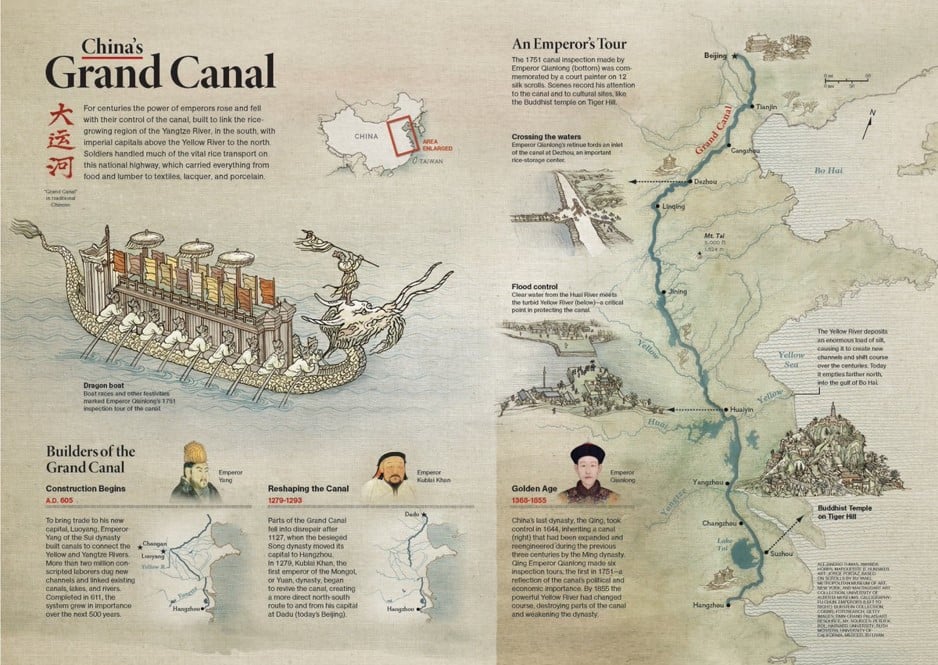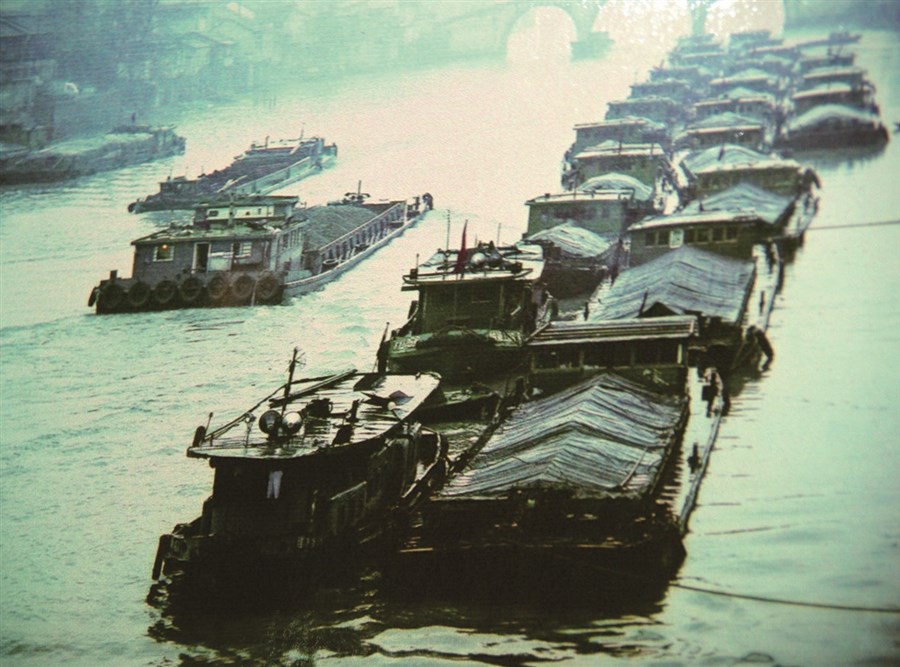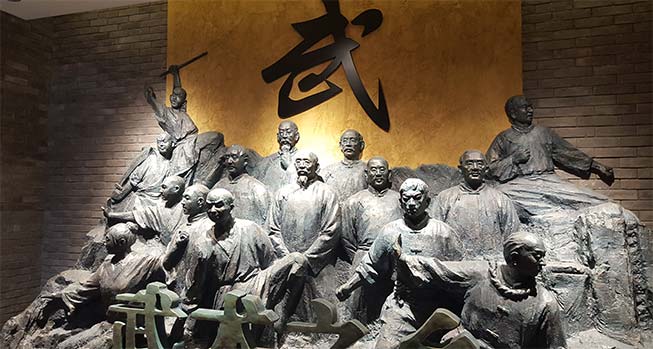Throughout history, Cangzhou’s martial arts have been used to defend the land, protect the people and secure the safe passage of goods. It has become more than a matter of heritage.

For generations, at the mention of those who courageous and brave, people would thing of Cangzhou. In the past, numerous heroes emerged from the greater Cangzhou -Tianjin – Hebei area. One day, over a century ago, Wang Zhengyi, a Da Liuhe Men (Six Harmonies Boxing) martial arts master from Cangzhou entered the courtyard at No.51 (present-day No.13) Xibanbi street, Zhishikou, Beijing. He walked down a narrow lane until he came to a three-roomed bungalow at its southernmost part. After taking one glance at the house, he decided to buy it. Three years later this humble building became famous across Beijing as the Yuanshun Protection Agency founded by Wang Zhengyi, a popular hero also known as—“great Sword Wang Wu.” Wang was the epitome of Cangzhou heroism. Today, when people look back at his broadsword and martial arts styles, they will find that his hometown of Cangzhou has given rise to legendary martial artists since time immemorial.
According to historical records, from the State of Yan (11th century–222 BC) to the Ming (1368–1644) and Qing (1644–1911) dynasties, many rulers established their capital in Youyan (an area around Beijing); and often fought over Cangzhou because of its proximity to the cap- ital. Ever since Duke Huan of Qi (reign: 685–643 BC) saved the state of Yan from invasion in 664 BC, wars frequently erupted around Cangzhou. Therefore, the people felt the need to practise martial arts to guarantee their survival.
By the Han Dynasty (206 BC– AD 220), the imperial government felt threatened by martial arts being practised so close to the capital. During the reign of Emperor Xuan of Han (73–49 BC), a famine occurred in Bohai Prefecture (present-day Cangzhou), and people rose up in re- volt. The government sent Gong Sui there as a prefect to force the locals to disarm and resume farming through a policy whereby farmers would “sell their swords and knives to buy oxen and calves for farming.” Guided by the local government, many farmers sold their weapons, bought cattle and farm tools, and began to till the land.
During the Yuan Dynasty (1271–1368) the Beijing-hangzhou Grand Canal passed through the area of Cangzhou; and the north and the south were linked by two major transport routes: Jingji (Beijing– Jinan) and Jingda (Beijing–datong). At that time, Cangzhou, Botou, Maozhou (present-day Renqiu City), Hejian and Xianxian—the centres of both water and land commu- nications—had become hubs for the sale of goods from Beijing, Tianjin, Hebei, Shandong and Henan, as well as key locations where professional courier services were provided for oicials or wealthy people. As the demand for martial artists and armed escorts sharply increased, men from across the country poured into Cangzhou, promoting the development of martial arts there.
Ancient Cangzhou, at the end of the Yellow River, was a place for banished criminals and a paradise for antigovernment rebels. During the late Qing Dynasty, some rebels who were wanted by the government, hid themselves in Cangzhou. Disguised as monks, Taoists or chivalrous men, they then began teaching martial arts to make a living, founding new schools and enriching the techniques of martial arts.
Ancient martial arts not only shaped the upright character of martial artists in Cangzhou, but also moulded their unique “martial and chivalrous morality.” An old saying goes: “Amend your conduct and improve your morals before practising martial arts.” Since the Ming Dynasty, all martial arts schools in Cangzhou have formulated rules governing the behaviour of their students to promote the national spirit.
A Master of Martial Arts

In 1874, Wang Zhengyi—a native of Cangzhou and also known as Wang Wu, (i.e. Wang the fifth) as he was the fifth child in his family. As a boy he became a disciple under the famous Cangzhou Da Liuhe Men Master Li Fenggang, who led the powerful Cangzhou Chengxing Protection Agency. Wang Wu studied arduously and became proficient in martial arts.
Years later Wang Wu moved to Beijing and established a new armed protection agency, named “Yuanshun.” At that time, armed courier agencies were experiencing a heyday and Beijing’s outskirts bristled with such agencies. Because of Wang Wu’s incredible strength, he wielded an extraordinarily large and heavy sword, earning him the sobriquet “Great Sword Wang Wu.” Three years later, the Yuanshun Protection Agency and “Great Sword Wang Wu” both became known far and wide. Yuanshun Protection Agency was located in the prosperous business area at the west end of Dongzhushikou outside of Qianmen, Beijing. In the agency’s yard, Wang would talk about current affairs with his friends, and later on transformed himself from a martial artist into a patriot. “With a sword falling on my neck, I look up at the sky and laugh sardonically; one has left and the other stayed, but both friends are as great as two Kunlun Mountains.” This is a verse from Yuzhong shi (“Poem Composed in Prison”), written on a prison cell wall by re- formist Tan Sitong (1865–1898). According to scholar Liang Qichao (1873–1929) in his Yin bingshi shihua (“Notes on Poetry from the Ice-drinking Studio”), “One of the two Kunlun Mountains refers to Kang Youwei and the other to swordsman Wang Wu.” Wang Wu first met Tan Sitong in 1875, one year after founding his agency. At that time Hu Zhiting, one of the five great courier masters in Beijing, recommended Tan Sitong to Wang Wu as a disciple. After accepting Tan Sitong, Wang Wu taught him to use a short-hilted knife and seven star sword.
In 1898, Emperor Guangxu (reign: 1875–1908) promulgated the Ding guoshi zhao (“Edict for State Reform”), starting a period of reform. Tan Sitong believed that reform was key to China’s future and so he worked hard to reconsider his own comforts. Wang Wu also felt a great deal of responsibility out of a concern that the opposition would attempt to frustrate the reforms. From then on, Wang became responsible for Tan Sitong and sent his best martial artists to safeguard Tan’s home. What’s more, secretly supported by Tan Sitong, he made friends with other martial arts masters in the hope they would side with the reformists. The Qing Government, however, was experiencing a conflict between the “Empress Party” repre- sented by Empress Dowager Cixi (regency: 1861–1908) and minister Rong Lu (1836–1903) and the “Emperor Party” represented by Guangxu. Despite not having any real power, Tan Si- tong and others hoped to carry out the reforms. Later, he placed his hope in warlord Yuan Shikai (1859–1916) who held the military power. One night, Tan visited Yuan, formulating a plan to subdue Cixi by killing Rong Lu and sending troops to surround the Summer Palace. Fi- nally however, Yuan betrayed Tan by telling Rong Lu of the plan and so the reforms failed, having lasted just 103 days.
Before his arrest, Wang Wu rushed to the Liuyang Guild Hall and exhorted Tan to go to the Yuanshun Protection Agency right away so that he could escape the city in disguise, accom- panied by armed couriers when the city gates opened at dawn. However Tan Sitong replied, “In no country have reforms been accomplished without bloodshed. I’ve never heard of anyone being killed for reform in China. That’s the reason this country isn’t prosperous. If some reformists must sacrifice their lives, I’d like to be the first one.” Finally, he bluntly asked Wang Wu to leave, and helpless, Wang Wu could do nothing but leave.
On September 21, 1898, the “Six Gentlemen” who had led the Hundred Days’ Reform were ex- ecuted at Caishikou. Despite the risk of being accused as a rebel, Wang Wu collected Tan Si- tong’s body, placed it in a coin secretly in his home and held a memorial ceremony for seven days before having him buried in Liuyang. Two years later, Great Sword Wang Wu also died. There were many rumours surrounding his death. The most legendary and heartrending said that on hearing that Wang was part of the Yihetuan Movement, Qing soldiers encircled his agency where he and his followers fought to the death. Wang Wu died from bullet wounds at the age of 56.
Legends about “Great Sword Wang Wu” still abound today. However, he remains relatively unknown in his hometown of Cangzhou, because, for the people living there, there have been countless others like him. For instance, Huo Diange (1886–1942)— sixth-generation master of Baji School, founder of Huo Family-style Baji Boxing (eight-extremities boxing), and martial arts teacher to the last emperor of the Qing Dynasty, Pu Yi (reign: 1908– 1911)—won martial arts contests by showing his skills rather than inflicting injuries. The outstanding characters of Cangzhou, M Wang Ziping (Chahua Quan) and Tong Zhongyi (Liuhe Quan). The fast hands of Lu Zhenduo (Mizong Quan), the war hero Sun Baye (Yanqing Men Mizong Quan), the proficient author M Jiang Rongqiao (Yanqing Men Mizong Quan), so many countless heroes, martial arts warriors and experts.
Martial Arts for a New Era
The legends surrounding martial artists in Cangzhou during the late Qing Dynasty have long become much told tales. Today, traditional rules of chivalry have been replaced by laws, and so carrying on martial arts has become a kind of responsibility for the people of Cangzhou.

Nowadays, hundreds of thousands of people practise martial arts in Cangzhou, accounting for about 40 percent of the city’s population. Of the 129 nationally recognised fighting styles in China, 52 originated in Cangzhou, below is a list of some of those main styles:
| 六合拳 Liuhe Quan 燕青拳 Yanqing Quan 迷踪拳 Mizong Quan 二郎拳 Erlang Quan 查滑拳 Chahua Quan 太祖拳 Taizu Quan 八极拳 Baji Quan 关东拳 Guangdong Quan | 唐拳门 Tang Quan 劈挂拳 Pigua Quan 八翻拳 Bafan Men 花拳门 Hua Quan 地躺拳 Ditang Men 埋伏拳 Maifu Quan 罗汉拳 Luohan Quan 飞虎拳 Feihu Quan 八盘掌 Bapan Zhang | 白猿通背 Baiyuan Tongbei 太祖通臂 Taizu Tongbei 通臂螳螂 Tongbei Tanglang 功力拳 Gongli Quan 弹腿门 Tantui Men 明堂拳 Mingtang Quan 勉张拳 Mianzhang Quan 麒麟拳 Qilin Quan | 太平拳 Taiping Quan 拦手拳 Lanshou Quan 沙教拳 Shajiao Quan 无极拳 Wuji Quan 义和拳 Yihe Quan 大洪拳 Da Hong Quan 青萍剑 Qingping Jian 五虎棍 Wuhu Gun |
It should be noted that there are countless branches or variations to those styles as well. Those variations are sometimes very significant as almost styles onto their own but it would become complicated to separate all the lineages and the areas that practice the variations.
People in Cangzhou call martial arts “Bashi,” and the yard where they practise “Bashifang,” which is usually in the teacher’s home so as to facilitate teaching. Bashifang generally consist of a two- or three-roomed bungalow, in which apparatus such as stone dumbbells and stone rollers are kept; and a weapon rack near the wall holding several long and short weapons.
The martial arts of Cangzhou are especially effective in combat. The movements are forceful, rough and deft with only three or five movements enough in a fight. This widely differs from the movies where fighters first pose, move around, frequently raising their legs very high, and then fight with no less than a dozen movements. In real combat however, people rarely raise their legs high, as it is easy to lose your balance this way and so can’t punch hard. As the saying goes, “When practising martial arts, three years is a little short, six years isn’t long, and ten years is enough.” Today, practitioners in Cangzhou know that they must have a strong will if they want to learn martial arts well.
Martial arts occupy a special space in Chinese culture, from where various wonders and legends have arisen. Cangzhou has produced enough legendary martial artists to fill several novels. Today, although Cangzhou’s martial artists adopt varying styles, they’re all engaged in the same pursuit. This shows the power martial arts has to bring people together and create legends.
